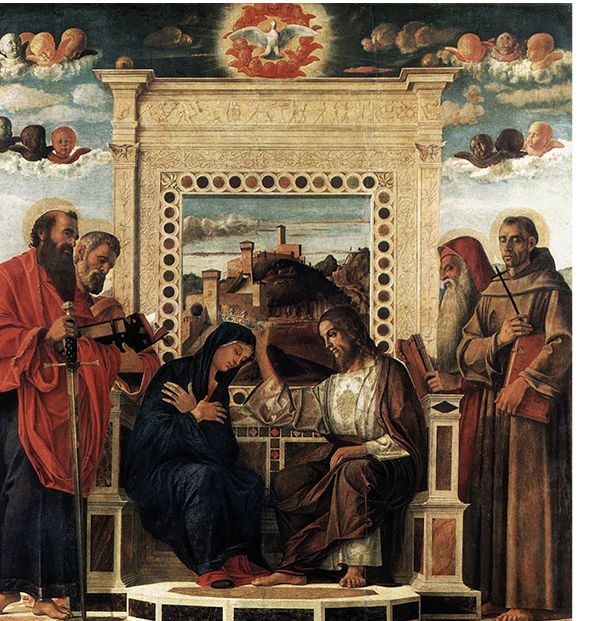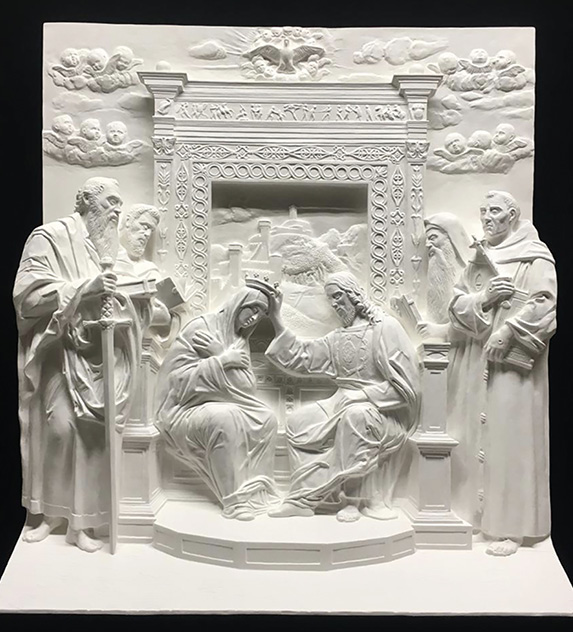A project initiated during the pandemic as a dream resulted as a reality. Thanks to the collaboration between the Istituto Francesco Cavazza and the Italian Blind Union, Urbino Chapter, today blind and visually impaired persons can experience a masterpiece of painting by the Venetian artist Giovanni Bellini. The Pesaro Altarpiece is a Renaissance work consisting of a frame at the centre of which dwells an imposing Coronation of the Virgin, oil on panel of undisputed aesthetic quality. In the predella, the lower section of the altarpiece, are seven scenes from the lives of Saints George, Paul, Peter, Jerome, Francis and Terence, with a touching Nativity in the centre. On the sides, two pillars house further effigies of sanctity. Giovanni Bellini created this architecture of visual and intellectual values around 1475.

The Coronation of the Virgin is an example of mastery expressed in form and colour. Here the Venetian painter depicts the Virgin, crowned by her son Jesus, in the presence of four Saints, recognizable by the attributes that connote their identity. On the left, we see St. Paul holding the hilt of his sword in his right hand, a white weapon that alludes to the martyrdom he suffered by beheading, as well as the spiritual warrior, while in his left hand he holds the book of letters written to the Christian communities. The book returns to St. Peter’s, placed in the background. On the right we find St. Francis of Assisi, wearing a cloak, marked by the stigmata, with the cross in his right hand and a book in his left, and St. Jerome, portrayed in the cardinal’s robes, holding a tome of sacred scripture. Let us remember how the attribute of the book always alludes to wisdom, hence to the divine word translated into a form readable and comprehensible to man. The throne on which the Virgin and Jesus are seated, placed to the left and right of the reader respectively, is decorated with marble inlays. The artist’s signature “IOANNES BELLINVS,” placed on the throne step, attests to the authorship and certain attribution of the masterpiece to Giambellino. Christ, wearing a light-coloured, damask robe, raises his right hand, holding the crown, to place it on the bowed head of the Virgin, whose posture of crossed wrists and hands on her chest is a sign of acceptance and obedience. On the entablature of the throne, a decorated frieze depicts scenes of war between Miltiades the Elder and the Lampsacens.

The episode, narrated by Herodotus, in which reference is made to the capture and subsequent release of the Athenian soldier at the behest of the King of Lydia, Croesus, is perhaps a reference to earthly defeats and victories. On the back of the throne, there is a window through which one can glimpse a hilly landscape and a fortress that, according to some sources, can be identified with the Castle of Gradara, although one cannot exclude an ideal representation of the city of Jerusalem and, credibly, a reference of a political nature to the annexation of the city of Pesaro to the possessions of the Sforza Seigniory, known for building fortifications. The flooring that introduces the Coronation scene is composed of precious marble inlays and draws geometries that reinforce the central perspective vision. The painting, in its solemnity and monumentality, is an expression, together, of theological and political content. Centrally dominating the scene, on the edge of the upper frame of the throne, is the dove, symbol of the holy spirit, surrounded by cherubs and flanked by theories of angels.
The Imago potestatis of the Coronation is thus the celebration of a civil and religious power at the same time, surmounted at its origin by the Imago pietatis, to which it is useful to refer in order to consider the message of life and death, finiteness and eternity, contemplated here. A tacit sacred conversation seems to be engaged between saints and angels. The emphasis, placed on the hieratic nature of the scene, highlights a dialectic existing between finiteness and eternity. The quality of the studied and tested translation in perspective bas-relief of the Coronation, faithful in every rendered detail to the original, is an example of the search for the aesthetic equivalent, flanked by a set of calibrated relief drawings, realized using the Minolta technique. The series of drawings is functional to make the articulated pictorial complex, in its specificities of form and substance, tangible by touch, while the support offered by the descriptions is aimed at the iconographic interpretation and haptic exploration of the typhlological materials designed and produced in the Anteros Tactile Museum. A training course reserved for the guides of the Pesaro Civic Museum completed the delivery of these tools dedicated to a properly inclusive museum education service.




.png)